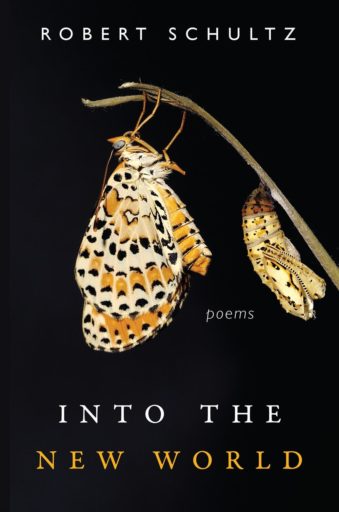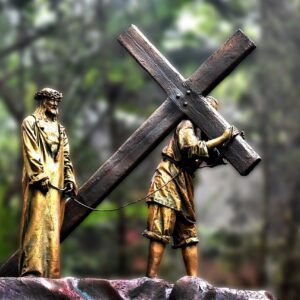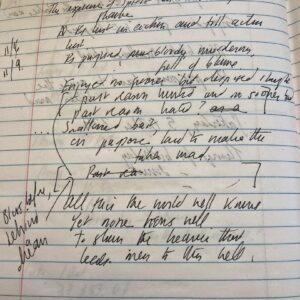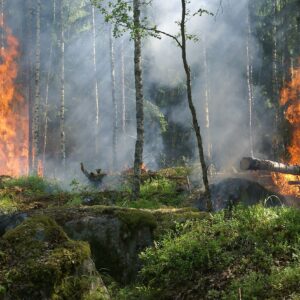When the magnitude of the possible Dawned—a morning doubly brilliant— Many were so near they vanished instantly. Others ran to the city’s rivers, naked But indistinguishable, woman from man. As a black rain fell on the fires, the wounded Dug for the buried wounded.
These lines from the long opening poem of Robert Schultz’s new collection from Slant Books, Into the New World, evoke the Hiroshima and Nagasaki atomic bombings. The morning is “doubly brilliant” from the dawning sun plus the bomb’s unspeakably bright blast.
These lines also introduce the major motifs of the book’s two longest sections: in Part I, fire; in Part II, war.
Fire burns in nearly every poem of Part I. Most of the burning is metaphorical. “Marriage Fires,” for instance, begins:
Where on the spectrum of living fire Do a man and woman walk this morning Through woods above a shallow river Late in March? In winter they dozed And smoldered coolly, or flared inside Like ice on skin, a flame that numbs.
Or in “Two or Three Dreams of Spring”:
And the grass, having sipped Its snowdrifts down, Burns green as Ireland While tulips burn In their bed by the porch An unearthly red…
But there’s literal fire, too—of course in the lines already quoted on the atomic bomb blasts, and also in the book’s title poem, which focuses on a ten-story high “scorched black cube” in Harlem, its “blackened girders like Gothic arches.”
There’s so much fire and burning in these poems that the speaker of Part I seems a poetic pyromaniac. But I’m attracted to this speaker: not despite all the burning but because of it. I like that the very different tones and topics of this group of poems are unified by a single image. I can’t think of many other poetry collections that do this.
One that famously does is Whitman’s 1855 Leave of Grass, in its identification throughout with all people, whatever their activities, gender, or condition. And it’s Whitman who offers Robert Schultz two of his core images for Part II of Into the New World. The poems of this Part all focus on wars: our Civil War plus the wars in Vietnam and Cambodia. But instead of the expected “fire” as dominant image for war poems, Schultz chooses “leaves” and “grass.”
Our clue that Whitman will be the guiding spirit of Part II is the epigraph of the very first poem, “Gettysburg”:
The real war will never get in the books. —Walt Whitman
In response, “Gettysburg” begins—
But the real books will always be filled with leaves, And real leaves have always grown from the dead, So the dead will always return in the books.
—which draws on Whitman’s images in “Song of Myself” (here in the original, 1855 version):
A child said, What is the grass? fetching it to me with full hands; How could I answer the child?… I do not know what it is any more than he. I guess it must be the flag of my disposition, out of hopeful green stuff woven, … And now it seems to me the beautiful uncut hair of graves. (ll. 90-101)
But the poem of Schultz’s Part II that draws even more fully on these lines of Whitman’s is “Up from its Ground the Water” (one of the series of poems focusing on the horrific actions of the Khmer Rouge in Cambodia):
From crowded graves the dead surge We see them now In the flesh of leaves Their faces rise
Of course, Whitman’s lifelong title for his poetry collections was Leaves of Grass. And “leaves” and “grass” sprout everywhere in these war poems of Schultz’s. In “Amulet”:
He sits on the grass, in sun. Like so many leaves The men have fallen.
In “Camouflage,” where the speaker is an American fighting in Vietnam:
I wear leaves On my helmet, put my faith in leaves To keep me safe. I trim myself in camouflage And dress in swirling shades of green to hide In fractured light. I disappear in the land And can’t be found, a casualty of war Before I’m gone, a ghost that stalks Vietnam.
Then there’s “The Chankiri Tree”—with its extraordinary debt to Whitman. The poem vividly evokes the dreadful “killing fields” of Cambodia, which the speaker has recently visited. The final four verses are worth quoting in full:
In a low building, victims’ photos, hung In rows of black and white, draw the murdered present. I scan across the peering eyes, struck dumb. Back outside in the glaring sun, leaves are stung With images—faces risen, called up and sent To green the tree of knowledge rung by rung. See, they return: In the wide ditch new grass has sprung Where bones still lie, shaded by the tree’s broad tent. When a breeze moves, leaves whisper what they’ve become. The bark is torn. Against this trunk executioners flung The bodies of children. Bullets, costly, were rarely spent. We climb the tree of knowledge rung by rung. O I perceive after all so many uttering tongues.
Those “victims’ photos”: photographs are another image that recurs in these war poems. But then we’re back with Whitman’s leaves of grass rising from graves: in the killing fields, “new grass has sprung / Where bones still lie”; and the tree’s leaves “whisper what they’ve become.” The horrifying picture of children’s bodies hurled against the tree then culminates in the poem’s closing line:
O I perceive after all so many uttering tongues.
When I came to this line, I thought: I’ve read this before. I went back to the 1855 “Song of Myself,” and yes, there it was, line 110. Here’s Whitman’s context:
This grass is very dark to be from the white heads of old mothers, Darker than the colorless beards of old men, Dark to come from under the faint red roofs of mouths. O I perceive after all so many uttering tongues!
I was thrilled to find Whitman’s exact line embedded in Schultz’s poem—because this embedding silently but intimately connects these Cambodian deaths with those that Whitman evokes throughout Leaves of Grass: deaths of all times and places.
Finally, I can’t leave “The Chankiri Tree” without noting its rhyme scheme—that of a villanelle. A few other poems in Into the New World follow a strict form, including the ghazal, sonnet, and terza rima, while there’s also some slant-rhyming elsewhere. Many of the remaining poems, though foregoing rhyme, engage us by keeping a beat going: anything from dimeter to hexameter.
But I must close by returning to one of Schultz’s key images—because that’s what he himself does. His final poem, “Analysis,” on chopping oak till the axe-head gets stuck in the wood, ends with these lines:
I pry and hammer, pry ’Til the splitting handle snaps, Then carry the whole With its swallowed wedge Back home to my grate, Where the knot I could not Break with my axe, The fire unties.
So the book comes satisfyingly full circle, ending as it began: with (here a literal) fire.
Peggy Rosenthal has a PhD in English Literature. Her first published book was Words and Values, a close reading of popular language. Since then she has published widely on the spirituality of poetry, in periodicals such as America, The Christian Century, and Image, and in books that can be found here.





